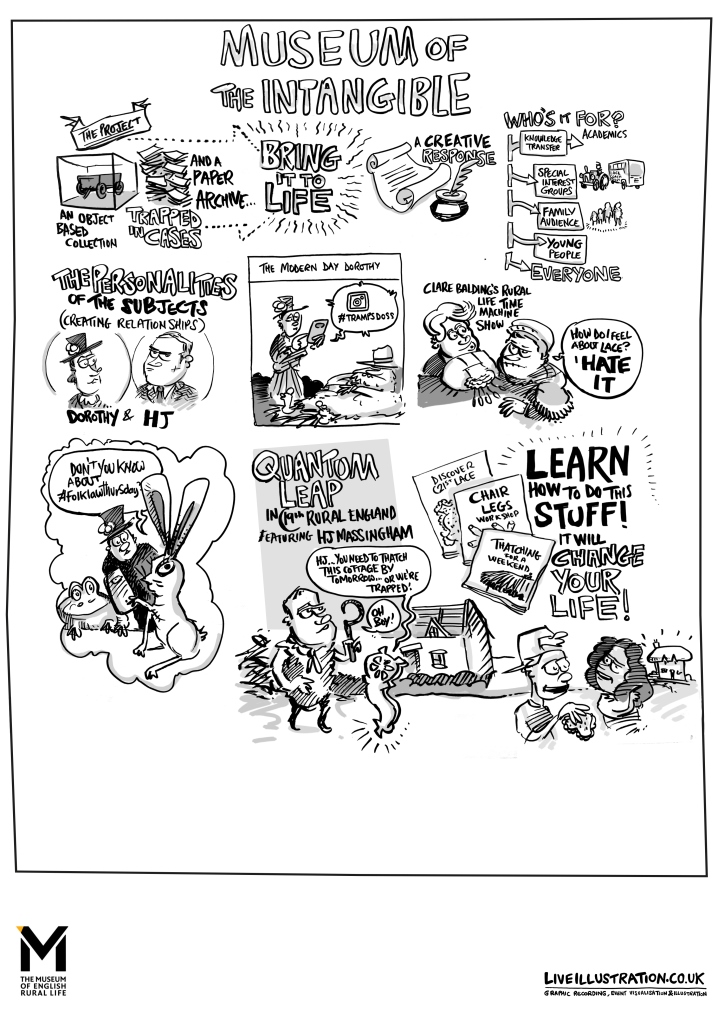Museum of the Intangible

Making, Using and Enjoying: The Museum of the Intangible explored the potential of intangible cultural heritage (ICH) and creative and digital practice to improve understanding of collections. Different stakeholders examined holdings drawn from the tangible assets of the Museum. In particular, these were materials connected with Anderson, H. J. Massingham, and Dorothy Hartley. Rather than simply gathering more stuff, the project brought people together around things, and used living experience to reveal hidden systems of knowledge.
Activity began with workshops designed to spark new thinking. The Museum then commissioned responses from participants. The project team also hosted an academic workshop to help shape the impact and research agenda of future work on ICH. Web development was completed that now allows for online exhibitions that draw from across archival, object, and library holdings. New thesauri centred on manufacturing processes were devised to add further depth to our understanding of making.
The project culminated with the release of a publication designed to help arts and heritage organisations use a combination of ICH ideas and creative practice to engage and enrich the lives of new audiences. You can find out more about the diverse range of creative responses commissioned through the project by accessing the toolkit (also available in hard copy format in The MERL Library), or by exploring the descriptions and links below.
Georgina Barney and Kate Genever : The Museum of Contemporary Farming
The Museum of Contemporary Farming was a participatory artwork on Twitter, that culminated in public events and small displays. Content was proposed using the hashtag #MuseumContemporaryFarming and the best ideas then featured in an exhibition in The MERL stores, alongside ‘scratch drawings’ by Kate (now acquired into the Museum’s collection).
Visit the Museum of Contemporary Farming website
See the project on Twitter: @MofCFarming / #MuseumContemporaryFarming
Chip Colquhoun: Life of the People
Chip created vodcasts based on folk tales bout makers such as farriers, blacksmiths and charcoal burners. Two episodes involved an apprentice learning basic skills from a master craftsperson. There were also live, interactive interviews, where viewers had the chance to ask questions about aspects of craft.
Watch on the Life of the People Youtube channel and follow on twitter @MERLLife
Felicity Ford: Knit a song of shepherds
Felicity ran a series of knitting workshops at The MERL, designed to combine processes of knitting and listening, and to contemplate objects associated with the history of yarn. Participants knitted small projects using a specially-selected yarn while listening to related sound recordings.
Visit the relevant page on Felicity’s website.
Teresa Murjas: I, Sheep
Teresa joined forces with onetime Poet-in-Residence Jack Thacker, partnering with his family farm in Herefordshire to develop i-Sheep. This film captures life from the sheep’s-eye perspective, using a Go-Pro camera, seeking to explore the animal’s experience. The project culminated in a piece of work including film and poetry.
The filmpoem launched on The MERL Youtube channel on 24th July, 2020
Hannah James and Geraint Parfitt
Geraint, one of only a handful of clog-makers in the UK, made a pair of clogs for Hannah, who developed a new work, ‘Muscle Memory’ based on some of the ICH linked to clog-making, clog-wearing. and clog-dancing. Hannah premiered her new performance work at The MERL Annual Lecture on 6th November, 2018. You can read more about the commission and performance in this blog. She has also created a short ‘how-to’ clog dancing tutorial for use in the Museum. After their use in the real world by Hannah, the clogs will be added to the Museum’s collection.
Watch a Hannah’s film of her meeting with Geraint, the performance of ‘Muscle Memory’ and the clog-dancing tutorial on our Youtube channel.
Alexandra Harris: After Michaelmas
Alex is best known for longer writings and broadcast work. She wrote a short story set in eighteenth-century Sussex, telling the story of a woman’s life through the items listed in her will. It was inspired by historic probate inventories and items in The MERL collection, which were similar to those found in such inventories.
Melissa Harrison: Bone Bobbins, Thatching Tools, and The Bodger’s Boy
Melissa is best known for her novels, but was keen to try her hand at poetry and wrote three debut poems. Each poem was inspired by items from the collection: bone lace bobbins; thatching tools; and an extract ‘Made in England’ by Dorothy Hartley.
The Museum of the Intangible was funded by the Arts Council England (ACE) Designation Development Fund.
Read the Case Study on the ACE website.

